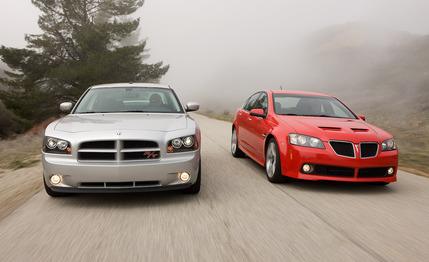 Comparison Tests
Comparison Tests
You may recall, ye disciples of wheelspin, that cars such as these—middle-class American sedans with big ol’ American pushrod V-8 engines—were once quite common. They were everywhere, and dads who brought home new cars with six cylinders risked excommunication by their teenage sons. It was the era of cheap fuel and four-barrel carbs, when domestic automakers sought to get us all to worship at the Temple of Torque. And this policy met with widespread success.
It’s no secret that this Old-Time Religion (OTR) is in decline today, the congregations drifting away, scattered by concerns about the price of fuel, concerns about where the fuel comes from, and concerns about the consequences of burning that fuel.
Whatever your CO2 position may be, it seems clear that there probably won’t be many more cars like these two. NASCAR’s so-called stock cars notwithstanding, Ford no longer acknowledges the Church of the Big Inch, at least not in sedans with any pretense of fun-to-drive. Only Chrysler and GM have four-doors that qualify for OTR vestments, and we’ve gathered this pair for side-by-side services, to see which does a more convincing job delivering the gospel.
One of these parishioners is well known to the faithful. The Charger, along with the Chrysler 300 and Dodge Magnum, revitalized the sect with the resurrection of the Hemi V-8, one of the church’s towering names from the glory days. The other is new, a heartening revivalist from a corporation that has largely eschewed rear-drive sedans since the mid-’90s. Although its face and name seem familiar, it comes to us from a faraway place, where winter is summer, and where exist vast spaces for one to chant the holy mantra of the OTR: Whooma! Whooma! Whooma!
It’s rare to have players so evenly matched as these. Both deliver thrust to the rear wheels, both are propelled by big V-8 engines with two valves per cylinder, punched open by rocker arms activated by pushrods riding camshafts deep in the engine block. Both are capable, in varying degrees, of smoking their rear tires. Both are substantial hunks, weighing in north of two tons. And both offer impressive performance for a relatively modest price.
But for all their OTR bona fides, the technology isn’t slavishly retro. Both engines are fed by port fuel injection, and both have cylinder deactivation to help keep them off the EPA’s gas-greedy list (although in vigorous driving, both are thirsty). Both our test cars had stability control, both had robust all-disc-brake systems with ABS, and both were equipped with automatic transmissions that included a shift-for-yourself manumatic feature.
So, as the Rev says to the congregation: Let us pray.